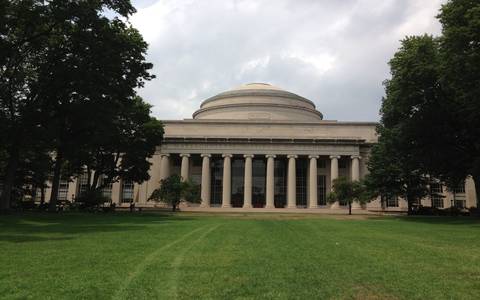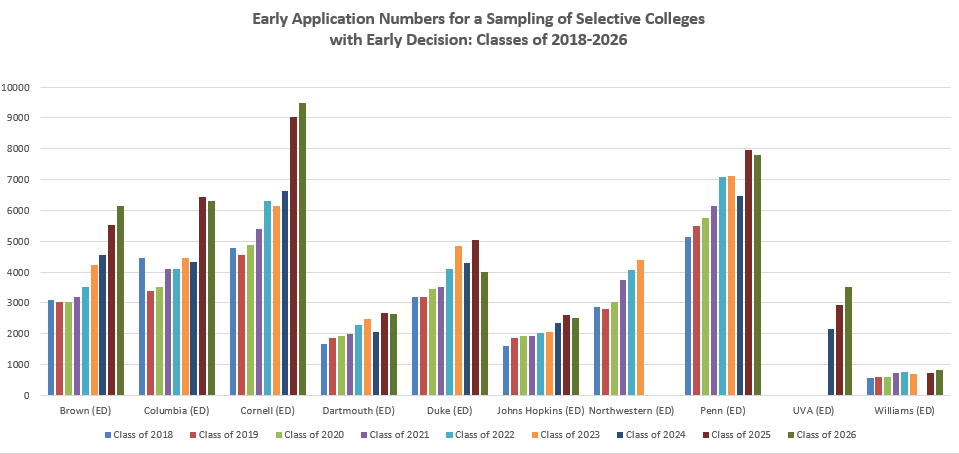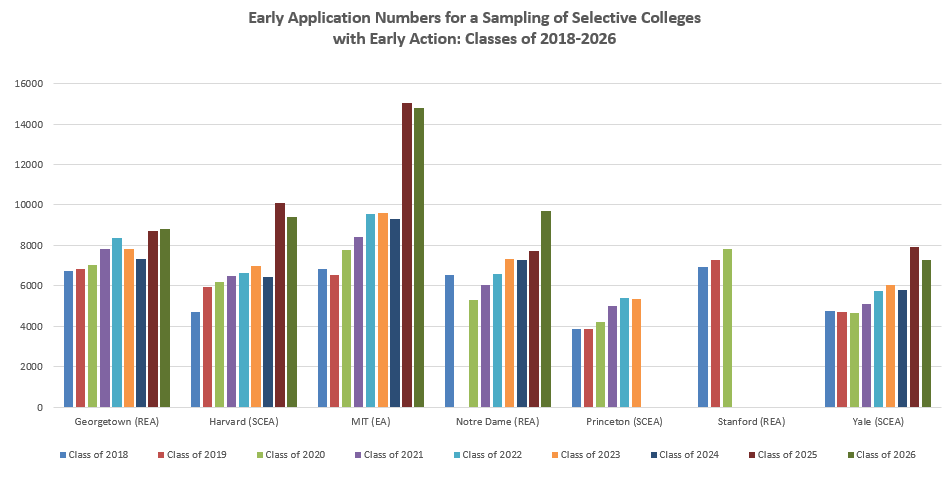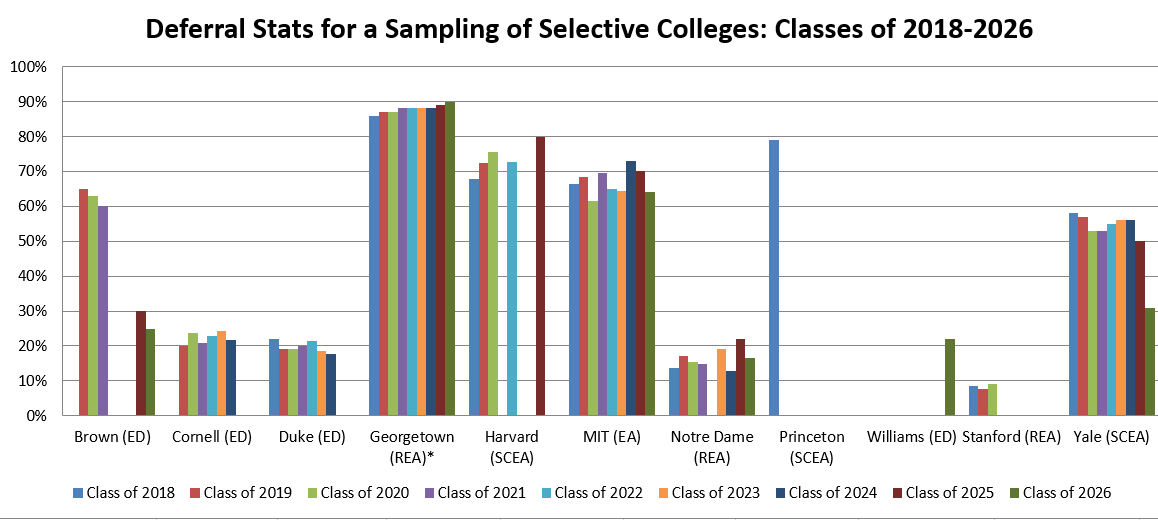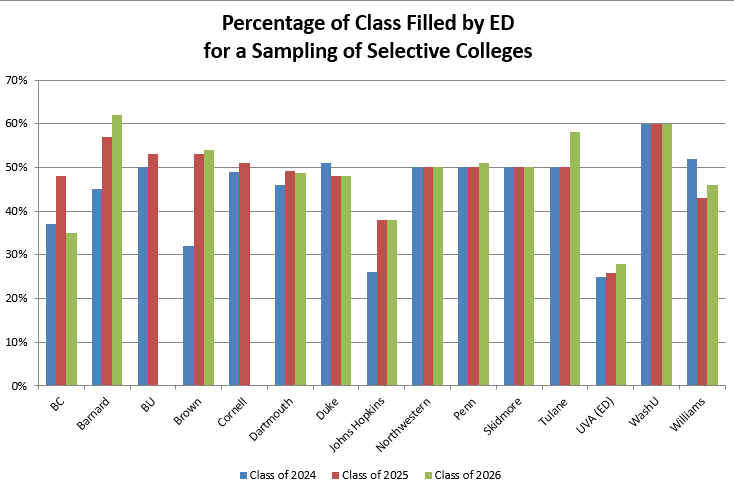This year—though still in the midst of a pandemic—was closer to a typical early college admissions cycle than last year. Students could visit colleges in person, participate in after-school activities, and were not struggling as deeply with ACT and SAT test cancellations. Most schools continued to offer test-optional admissions after the success of last year’s policy, and online interviews and video submissions have become the norm. Congratulations to all students who submitted early applications—your perseverance has hopefully been rewarded!
Whatever your early admissions outcomes, it is important to have an open mind and to maintain faith in the process of finding your best-fit school. In this blog post, we have put together an in-depth analysis of this year’s early admissions trends and statistics.
Overall Early Application Trends
In another year filled with uncertainty, more students may have applied early decision to gain some certainty. Also, test-optional plans at selective schools could continue to encourage some students to try their luck at colleges which previously seemed out of reach.
Most selective schools saw a slight dip in early applications from the extreme highs of last year, but the numbers overall were still very high and competitive. Brown was one of the few schools that saw another significant rise in early applications—an 11% increase this year over a 22% rise last year. Notably, Notre Dame saw a 25% increase in early applications from last year, and Emory had a 13% jump in EDI applications.
In conjunction with relatively flat or slightly decreased application numbers, acceptance rates rose slightly or remained consistent with last year. It’s important to note that many selective schools saw a significant decrease in their early acceptance rate last year.
Overall Early Application Numbers
The following graph compares early admissions application numbers and acceptance rates for the class of 2018 through 2026. As a refresher, early decision (ED) is binding and mandates enrollment; single choice early action (SCEA) and restrictive early action (REA) are restrictive but allow the student to wait until May 1st to decide; and early action (EA) is unrestrictive and non-binding. Early decision is typically associated with higher acceptance rates because the school is guaranteed enrollment, which increases the yield factor, and results in a class comprised of students who have demonstrated a high degree of interest.
Early Admissions Statistics for a Sampling of Selective Colleges
This year, UVA had a 32% overall ED acceptance rate, including a 37.8% in-state offer rate and a 25.1% out-of-state offer rate.
Notably, according to their admissions website, “Despite no binding agreement, Restrictive Early Action admitted students at Notre Dame historically enroll at close to a 70% rate.”
Deferral Stats
Deferral rates are not as widely published as acceptance rates. However, available information shows that many schools defer more than half of their early applicant pool to the regular admissions round.
Notable exceptions include Duke, Middlebury, Northwestern, Notre Dame, and Stanford, who deny most applicants who are not accepted in the early round. For these schools, deferral is used to indicate that your application is competitive and will be given serious consideration in the regular admissions process.
Some schools, like the University of Michigan, use large numbers of deferrals to control class size as they have continued to receive increasingly large early applicant pools. Some colleges defer especially strong candidates who may view the college as a “safe” school, wait to see if the student withdraws the application based on early acceptance by more selective colleges, and then may accept the student late-January through March.
For deferred students, there are several steps you can take to increase your chances of admission in Regular Decision, including re-visiting, arranging for an additional letter of recommendation from a 12th grade teacher, and sending a follow-up letter with updates. Above all, stay positive, and continue to do your best academically.
Percent of Early Apps Deferred for Recent Classes
Larger Percentages of Freshman Classes Filled with Early Applicants
Some schools continue to admit large portions of the freshman class through early admissions, making the regular admissions cycle even more competitive. More students tend to apply through regular decision, so they are competing for fewer remaining positions in the class.
Boston University, Cornell, Dartmouth, Duke, Northwestern, Rice, Skidmore, Tulane, Penn, WashU, and Williams admit 40% or more of their incoming class through their early decision program. Several colleges, such as Dartmouth, Duke, Northwestern, Penn, and Skidmore, seem to be intentionally keeping the percent at or just under 50%, perhaps due to the negative optics of filling most of their class through early decision (which typically attracts upper socioeconomic applicants who do not need to compare financial aid offers). The chart below shows the percentage of recent classes filled with early decision admits.
Increased Diversity Continues to be a Priority
Many of the most selective colleges continue to use early admissions for the big “hooks”: underrepresented minorities, lower socioeconomic, first-generation, and international students, as well as recruited athletes, and legacies. Schools with a high percentage of applicants who self-identify as students of color include Brown (51%), Dartmouth (40%), Georgetown (45%), Harvard (54%), Notre Dame (40%), Penn (52%), and Tulane (46%).
Legacy is another major factor, and schools accepting large numbers of early applicants with a family history of attending the school include Dartmouth (13%) and Penn. This year, Penn did not release the number of accepted ED legacies, but last year it was 22% of the ED admit pool. In the Ivy League, Penn typically has the highest rate of legacy acceptances.
International early admits continues to grow or remain steady, despite pandemic restrictions on in-person learning. Universities with high international early acceptances include Dartmouth (14%), Harvard (12.6%), Notre Dame (12%), Penn (12%), Rice (15%), and UVA (11.5%).
If you applied early to a highly selective college and do not fall into one of these categories, your chances of admission are significantly lower than the published average admit rates.
Over-enrollment for the Class of 2025
Last year, some schools admitted lower numbers for the Class of 2025, due to large numbers enrolling after deferral from the Class of 2024. For example, at Princeton, over 200 students deferred enrollment to the fall of 2025; as a result, the school admitted 20% fewer students than normal to this class. Duke had 10% of the Class of 2024 defer for a year, and also admitted fewer students through early and regular decision to the Class of 2025. Williams had 130 students defer enrollment and admitted 250 fewer students to the Class of 2025.
Last year, 25% more students chose to accept admission than the previous year at Tulane. Due to this over-enrollment, Tulane plans to admit 1,650 fewer early action applicants to the Class of 2026, making this EA cycle even more competitive than previous years. Tulane’s EA acceptance rate dropped to 10% this year.
Predicting yield from early action and regular decision programs, which are not binding, can be difficult for colleges, especially during a pandemic. Boston University also over-enrolled the Class of 2025 after a record-high increase in applications, and Purdue welcomed its largest incoming class ever to campus this fall.
Future Plans for Standardized Testing Admissions Policies
Most schools continued their test-optional admissions policies this year for the Class of 2026 admissions cycle. According to FairTest, “a new tally shows that nearly 80% of bachelor’s degree-granting colleges and universities are not requiring ACT or SAT scores from students seeking to enroll in fall 2022. More than three-fifth of all colleges and universities in the nation have already committed to remaining test-optional or test-blind for fall 2023 applicants.”
According to the Boston Globe, “The widespread adoption of test-optional admissions is being applauded by civil rights and equity advocates, who say it removes a significant barrier to entry for students of low income, students of color, and first-generation students. They argue such policies should become permanent.”
Harvard has already announced that “due to the ongoing COVID-19 pandemic and its continued impact on access to testing for high school age students, Harvard College will allow students to apply for admission without requiring SAT or ACT scores for the upcoming admitted classes of ’27, ’28, ’29, and ’30.”
Georgetown is an anomaly in that it continues to require standardized test scores and is one of the few selective colleges that has not offered test-optional admissions.
Not many schools have released their test-optional applicant stats for this admissions cycle yet, but those who have reveal that applying test-optional does not provide the same admissions chances. Notre Dame states 46% of this year’s early applicants chose test-optional and 30% of their Early Action admits did not submit test scores. At Barnard, 57% of ED applicants were test-optional and 49% of ED admits were test-optional.
More schools are also trending towards allowing superscoring of the ACT and SAT, in which the highest section scores are re-combined to form a new total.
We continue to recommend that students take standardized tests as part of the application process and submit scores if they are competitive. Keep in mind that test-optional is not the same as test-blind! Strong scores will still provide a competitive advantage in the admissions process.
School Policies on Sharing Early Admissions Stats
There is a growing divide in how colleges share their early admissions statistics. Schools like Brown, Dartmouth, Georgetown, Harvard, Notre Dame, Penn, and Yale, seem to share much information as to application numbers, average admit test scores, deferrals, and institutional priorities, such as diversity. This transparency can often help future applicants determine how to apply and admission chances.
There are other schools that have begun to pull away from sharing this information. Princeton, for example, recently decided to reduce the amount of information previously provided, stating:
We know this information raises the anxiety level of prospective students and their families and, unfortunately, may discourage some prospective students from applying. For this reason, we have in recent years stopped reporting the annual admission rate, as well as the admission rate by SAT score range and average GPA. We have now made the decision not to release admission data during the early action, regular decision and transfer admission cycles.
Similarly, Cornell adopted a policy to not share acceptance rates until after the admissions cycle has ended each year. As of the fall of 2018, Stanford stopped publishing admissions data.
Our Tips
We recognize how challenging the process of waiting for your admissions results is. Here are our tips for maximizing your chances:
- Send your favorite early admission colleges Letters of Continued Interest with updates about academics and activities
- Continue to engage in your academics; colleges want to see your midyear report and final report card
- Visit (or revisit) colleges in which you are most interested
- Keep a positive outlook and have faith in the process!
Deciding whether and where to apply early can be daunting, especially now. But whatever your question, Collegiate Gateway is happy to help you decipher your options and understand the changing landscape of early admissions.

